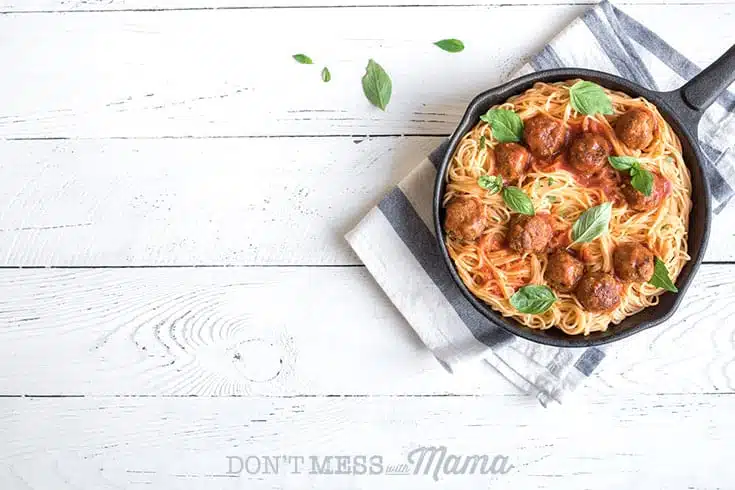How to Season Cast Iron Pans and Make Them Non-Stick
Check out this easy tutorial on how to season cast iron pans so they cook like non-stick – great for frying, cooking eggs or even pasta dishes. You’ll also learn tips for making cast iron cookware last for generations.

This post contains affiliate links. Please read my affiliate disclosure.
So you’ve bought a new cast iron pan, and are revved up and ready to cook, but hold it right there. You didn’t spend a small fortune on this pan so you could ruin it on your first meal. Cast iron cookware requires some tender love and care, so I’m going to share the secrets of seasoning and treating what will be your favorite kitchen addition… and I’ll show you how to season cast iron cookware to make them non-stick.
Getting Started with Cast Iron Cookware
Before you start using your cast iron cookware, there are a few things to consider.
1. Grease That Skillet
The most important thing to do with your cast iron cookware is to season it. Seasoning basically refers to using fat (such as coconut oil, lard or tallow) to add a natural, protective coating to cast iron pots and pans to prevent rusting and allow for non-stick cooking. The fat is heated on the pan, a process called polymerization, to add that protective coating. It can take several layers of seasoning to season a pan, but once it’s properly seasoned cast iron pans are similar to non-stick cookware.
2. Cook with Healthy Fats
Once a pan has been seasoned, it usually doesn’t need to be seasoned again – as long as a generous amount of fat is used to cook the food. This adds flavor and healthy fats (such as coconut oil, lard, tallow or ghee) to skillet dishes, and keeps the cast iron surface smooth and non-stick – similar to Teflon (but without the toxic chemicals).
Avoid cooking with vegetable oils, such as canola, cottonseed, soybean, grapeseed, and rapeseed oils. These oils are highly refined and processed, increase inflammation in the body, and can cause a number of health issues.
3. Don’t Wash, Rinse
After each use, rinse the cast iron pan with water and use a metal scrubber to get rid of excess food. Then let air dry. Do NOT use soapy water to clean the pan. Soap will remove that protective coating. The pan should have a slight greasy feel to it. In a pinch, it’s fine to way spot wash the handle and bottom of pan with a little soap. Just be sure none gets into the cooking area of the pan.
If the pan is washed with soapy water, just season it again. And if a pan has rust, wash with soap water and use a metal scrubber. Then season the pan to add that protective coating. Keep reading to learn how to season a pan.
4. Pre-Seasoned Cast Iron
Unless you got a cast iron skilled from your grandmother, chances are the cast iron cookware you’re using has been pre-seasoned. Cast iron cookware manufacturers do this to save you time from having to season a pan on your own. The only problem is that the oil typically used by manufacturers to season cast iron cookware is soybean oil – which is one of the worst cooking oils available.
You can remove the pre-seasoned oil by using a metal scrubber and some soapy water and kosher salt (along with a little muscle) to remove the pre-seasoned coating. This might take a few scrubs back and forth, again and again, to remove the coating. Once it’s gone, season the pan with a healthy fat.
5. Avoid Cooking Acidic Foods
Acid and cast iron cookware do not mix well. Acidic foods will actually absorb the color and taste of your cast iron pots and pans. Think about it, do you want the taste of metal in your tomato sauce? Use stainless steel cookware instead for acidic foods, like tomatoes
How to Season Cast Iron Pans and Make Them Non-Stick – Step by Step
Ready to season your cast iron skillet or pan? Here’s a quick tutorial on how you can do it.
What You’ll Need
- Kosher salt (better for scrubbing)
- Bristled scrub brush
- Dish soap (ask me how to get it 24% off)
- Paper towels
- Coconut oil
1. Scrub, Scrub, Scrub
Pour half a cup of kosher salt into your cookware and scrub with paper towel. Cast iron cookware is extremely porous, so the kosher salt with help to remove any dust or impurities that have become lodged in the metal.
Once you’ve scrubbed your cookware inside and out, wash it with hot water and dish soap. Now, preheat your oven to 400ºF so it’s ready for step 3.
Very important – Dry your cast iron cookware very well! You do not want the pot or pan to have any leftover moisture on it when you begin the next step.
2. Oil Up
Add 1-2 tbsp of coconut oil to a pan or paper towel and cover it in a thick layer of oil.
3. Turn Up the Heat
After the pan is slathered in oil, place it on your oven at 450ºF for 30 minutes, or until the surface is significantly darker than before. If your oven starts to smoke don’t worry, just have a towel ready to clear the smoke from your fire alarm.
4. Repeat
Repeat steps 3 and 4 until your pan is completely black (usually takes about 3 or 4 oil layers and heating sessions). In between each process, make sure that you give your cookware a chance to cool down to room temperature before covering it with oil again.
After that, you’ll have a perfectly seasoned cast iron pot, pan or skillet. Enjoy cooking your next meal.
Do You Season the Bottom Of Cast Iron Pan?
Once the pan is clean, use your rag or a paper towel to coat it with a thin layer of neutral fat, like vegetable oil or flaxseed oil. The important thing is to coat the entire pan with fat, and yes, that means the exterior, bottom, and sides of the pan.
Can I Ruin a Cast Iron Pan?
While your cast-iron skillet might be tough, it isn’t indestructible. There are a few surefire ways to ruin the seasoning, or worse, destroy your cookware entirely. Avoid these pitfalls to keep your pan in tip-top cooking condition.
- Not cleaning your cast iron pan can ruin it. Make sure to clean off any cooked on food.
- Don’t overheat your cast iron pan. Overheating or uneven heating can leave you with a warped pan.
- Don’t put your pan in the dishwasher, it will strip away that lovely seasoning!
- Don’t let it rust. Leaving a pan out to the elements and it will rust. Make sure to store it in a dry place.
Top Tips for Seasoning Cast Iron Pans
- Avoid cooking with vegetable oils, such as canola, cottonseed, soybean, grapeseed, and rapeseed oils. These oils are highly refined and processed.
- After each use, rinse the cast iron pan with water and use a metal scrubber to get rid of excess food. Then let air dry. Do NOT use soapy water to clean the pan. Soap will remove that protective coating.
- Acid and cast iron cookware do not mix well. Acidic foods will actually absorb the color and taste of your cast iron pots and pans.
- Dry your cast iron cookware very well! You do not want the pot or pan to have any leftover moisture on it when you begin the next step.
More Posts You Might Like
- 15 Gluten-Free Swaps for Your Favorite Foods
- How to Make Your Own Almond Milk
- Gluten-Free Real Food Recipes for Families
Did you try this? Don’t forget to rate it and comment below to let me know how it went. You can also FOLLOW ME on Facebook, Instagram and Pinterest.

Seasoning A Cast Iron Pan
Equipment
- Bristled scrub brush
- Paper towels
Ingredients
- 1/2 cup kosher salt
- 1-2 tbsp coconut oil
- 1 tsp dish soap
Instructions
- Pour half a cup of kosher salt into your cookware and scrub with paper towel. Cast iron cookware is extremely porous, so the kosher salt with help to remove any dust or impurities that have become lodged in the metal.
- Once you’ve scrubbed your cookware inside and out, wash it with hot water and dish soap. Now, preheat your oven to 400ºF so it’s ready for step 3.
- Very important – Dry your cast iron cookware very well! You do not want the pot or pan to have any leftover moisture on it when you begin the next step.
- Add 1-2 tbsp of coconut oil to a pan or paper towel and cover it in a thick layer of oil.
- After the pan is slathered in oil, place it on your oven at 450ºF for 30 minutes, or until the surface is significantly darker than before. If your oven starts to smoke don’t worry, just have a towel ready to clear the smoke from your fire alarm.
- Repeat steps 3 and 4 until your pan is completely black (usually takes about 3 or 4 oil layers and heating sessions).
- In between each process, make sure that you give your cookware a chance to cool down to room temperature before covering it with oil again.
- After that, you’ll have a perfectly seasoned cast iron pot, pan or skillet. Enjoy cooking your next meal.
Notes
Want More Recipes?
Check out my new book, Gluten-Free, Real Food Recipes for Kids.
I wrote this book with YOU in mind. Parents who want to provide kids with wholesome meals without artificial colors, preservatives and other additives.
All the recipes are gluten-free – with many options for grain free or Paleo, dairy free, egg free and vegetarian.
What’s Included In This Book
It’s filled with 130+ pages of content and recipes, including:
- Real food nutrition 101
- Detailed information on how to properly soak and sprout nuts, beans, grains and seeds
- A guide on how to spot chemical additives and what to avoid
- Kitchen essentials and cooking tools
- Tips on how to get kids to become better eaters and help in the kitchen
- 70+ gluten-free recipes – such as snacks and appetizers, beverages, condiments and dressings, main meals, desserts and more

